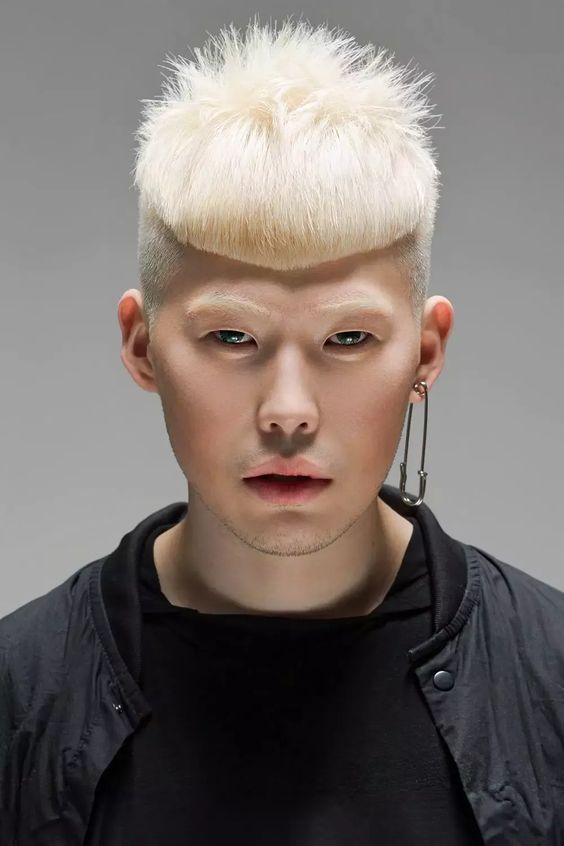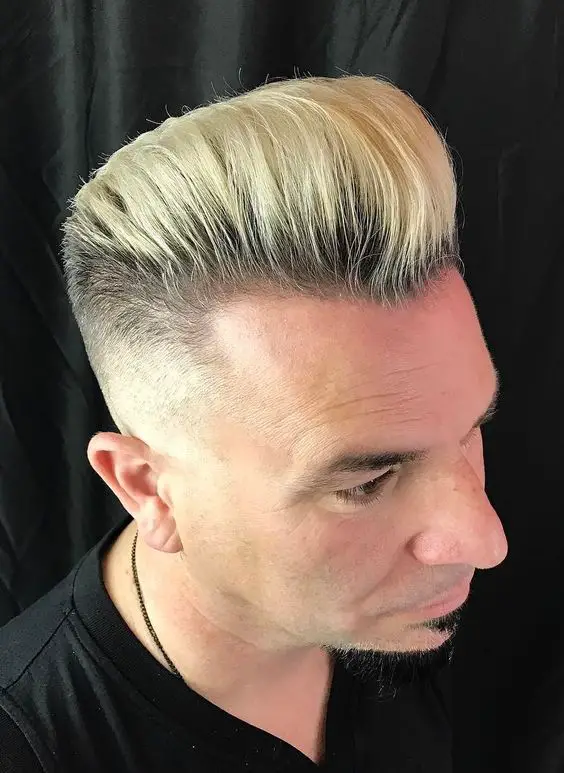A guide to a variety of men’s hairstyles for blondes 16 ideas
The allure of blonde hair has always held a unique place in fashion, symbolizing everything from the sun-kissed surfer aesthetic to the rebellious edge of punk culture. In this exploration of blonde hairstyles for men, we delve into various looks that not only define personal style but also showcase the versatility of blonde hues. Whether it’s the natural golden locks that evoke a sense of freedom or the meticulously bleached strands that speak to a fearless sense of self-expression, each hairstyle we’ll discuss offers a window into the personality and fashion sense of the individual.
The Understated Edge
The first look is a harmonious blend of short sides with a straight top, achieving a clean and contemporary style. This hairstyle exudes a sense of precision and neatness, with the dark roots subtly enhancing the depth and texture of the platinum top. It’s a statement of controlled aesthetics, perfect for the man who appreciates a minimalist approach with a touch of sophistication.
The Bold Contrast
A striking example of short straight hair juxtaposed with a dramatic blonde, this style captures an edgy yet accessible look. The dark undercut provides a stark contrast to the bleached blonde on top, creating an eye-catching dichotomy. It’s a powerful statement that balances boldness with wearability, ideal for those who are not afraid to stand out in a crowd.
The Curly Charm
Here we see a celebration of curly hair, where the natural curls are accentuated by a honey blonde tone that adds warmth and depth. The short back and sides allow the curls on top to become the focal point, offering a look that’s both aesthetic and effortlessly cool. It’s a style that says laid-back and approachable, with a sunny disposition.
The Platinum Wave
In this image, the short platinum waves give off a modern vibe that’s both chic and rebellious. The wavy texture adds a dynamic edge to the otherwise sleek and short cut. This style is perfect for those who want to make a statement while maintaining an air of elegance and trendiness.
The Sandy Sweep
This hairstyle features a long top swept back to reveal a subtle fade on the sides. The sandy blonde shade is a nod to the surfer lifestyle, suggestive of days spent at the beach and nights around a bonfire. It’s casual yet stylish, offering a versatile look that can transition from day to night with ease.
The Sleek Sophistication
A testament to the timeless appeal of straight hair, this long and sleek style is tinged with a light blonde hue that suggests a meticulous and polished individual. The hair is styled back, creating a clean line that frames the face and exudes a sense of refined confidence.
The Classic Fringe
This image showcases a straight fringe with a textured top, presenting a classic yet youthful look. The rich brown undertones of the blonde hair add a natural and inviting warmth, making it a versatile style that suits a variety of settings, from the professional to the social.
The Artistic Expression
Next, before us is a bold and artistic version of blonde hairstyles. The white blonde color is applied with precision, creating a high-contrast look that is almost futuristic. The short sides and long top give you the opportunity to express individuality, making this hairstyle the perfect choice for the avant-garde.
The Textured Top
Encapsulating the messy look, this hairstyle is a testament to the carefree and adventurous spirit. The short curly top, tousled with a light touch, is both playful and practical, providing a look that can handle a day out just as well as a night on the town. It’s a nod to the spontaneous man, ready for where the winds of whimsy might take him.
The Defined Fade
Precision and crisp lines define this look, where a short back and sides fade meets a straight and combed top. It’s a look that speaks to the meticulous man who values sharp aesthetics. The golden tone of the hair adds a warm and inviting hue, perfect for those who carry an air of professionalism with a dash of charisma.
The Sunlit Casual
This style is all about the effortless wavy hair, giving off a short platinum beach vibe. The soft waves are reminiscent of the ocean’s caress, ideal for the man with a laid-back attitude and a penchant for summer romances. It’s a style that doesn’t try too hard, yet speaks volumes about the wearer’s relaxed approach to life.
The Urban Edge
The short sides and voluminous top of this hairstyle blend urban chic with a touch of rebellion. The ash blonde hair is streaked with dark roots, offering a contrast that’s both striking and trendy. This style is for the man who strides confidently through the city streets, his hair as much a part of his identity as the clothes he wears.
The Classic Pompadour
A timeless classic, the pompadour here is given a modern twist with a light blonde shade. The hair is swept back and up, creating a look that’s both elegant and commanding. This hairstyle is suited for the man who respects the classics but isn’t afraid to stand out in a contemporary world.
The Spiky Statement
For those who dare to be different, this spiky short platinum style is a bold declaration of individuality. The short sides allow the textured top to truly pop, making it a centerpiece of conversation and a hallmark of personal style. It’s for the trendsetter, the trailblazer, the man who walks his own path.
The Artistic Rebel
This style is the epitome of art and aesthetic, where the white curls are as much a statement of creativity as they are of fashion. It’s a canvas for expression, paired with the individual’s unique features to create a masterpiece of personal style. This look is for the artist at heart, unafraid to showcase his inner world on the outside.
The Silver Fox
Lastly, we have the short and sleek white hairstyle that oozes sophistication and a sense of wisdom. It’s a clean and mature look, signaling a man who knows himself and his place in the world. This hairstyle is for the modern gentleman, one who carries his experiences with pride and style.